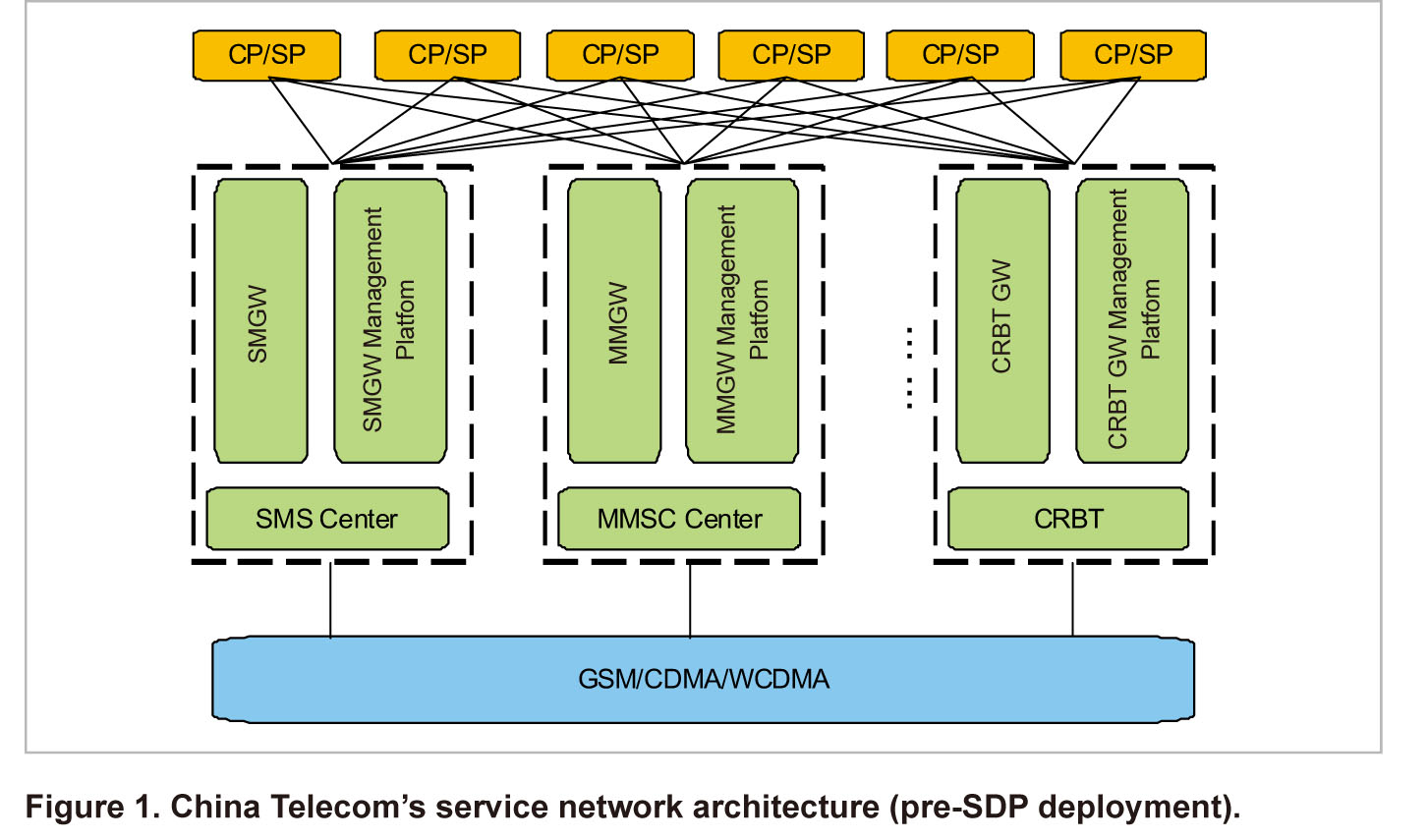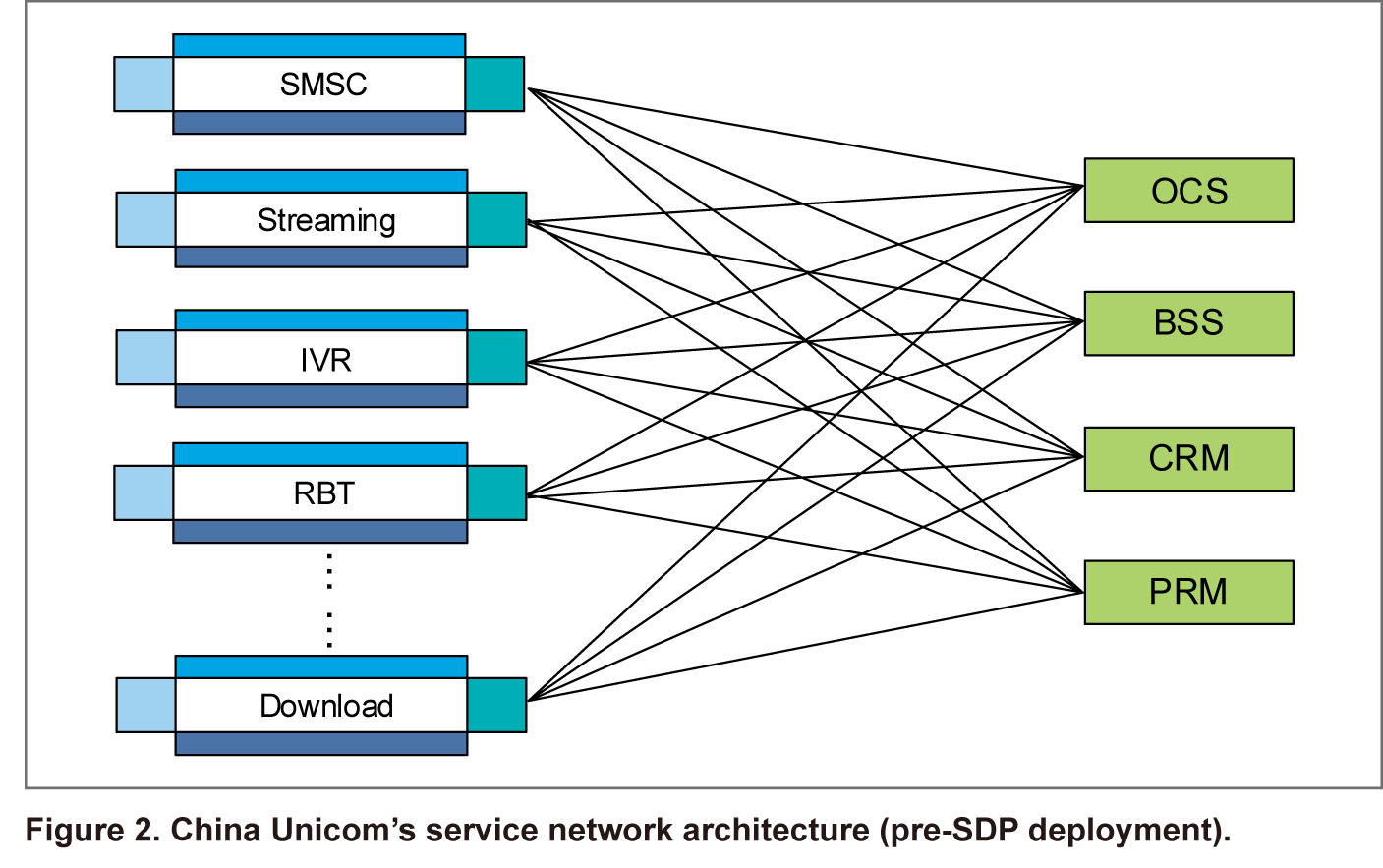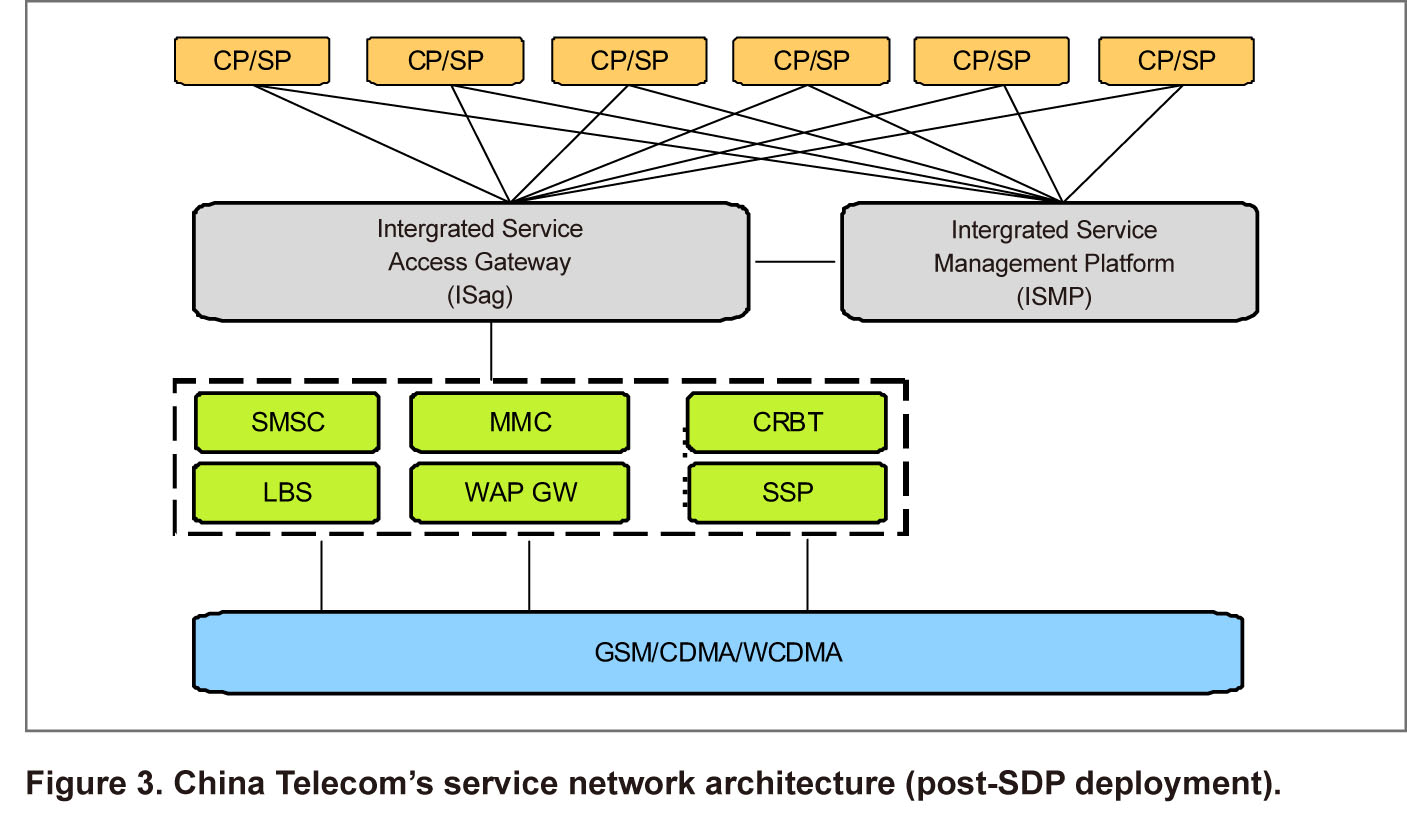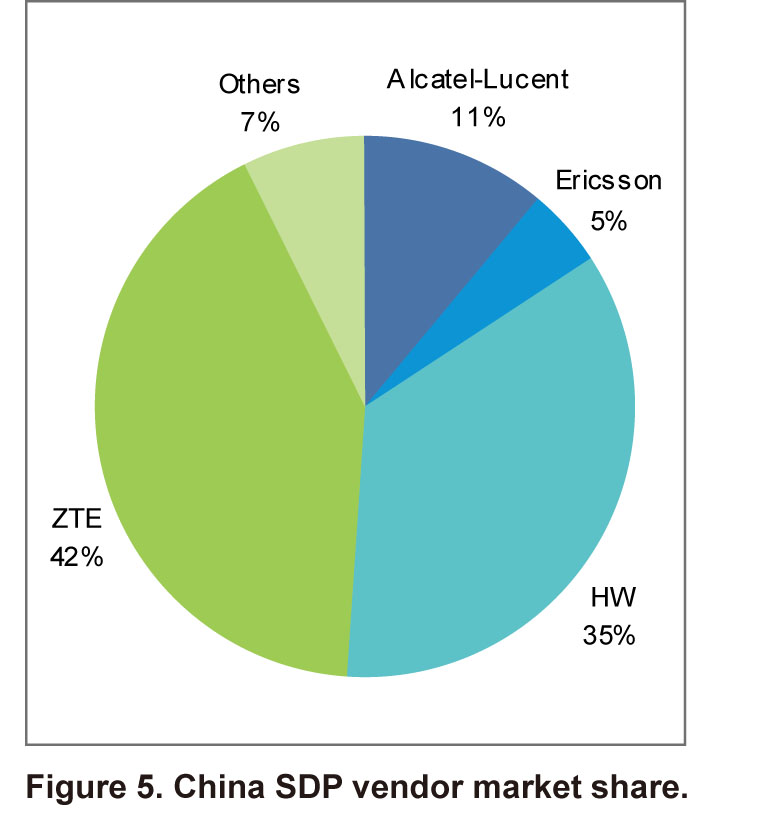Service Delivery Platform Developments in China
Conditions Before the Introduction of SDPs in China
In China, there are three major telecom players: China Telecom, China Unicom and China Mobile.
China Telecom has around 350 million fixed line network users. In July 2008, China Telecom acquired the CDMA network of China Unicom supporting around 30 million CDMA users. As a result, China Telecom’s existing service network structure is quite complex (see Figure 1).

The service network is made up of separate “silos” and it is very difficult for China Telecom to achieve its strategic transformation from a conventional telecom provider to a comprehensive information service provider. The existing network architecture cannot meet the requirements of end customers, SPs, CPs and of the operator itself. For example:
■ Customers need a greater choice of services and of access methods (i.e. one point of access for all network services). They want more converged services, plus fraud and privacy protection from SPs that abuse the system.
■ CPs and SPs also suffer from the existing network platform because they require more open network access. They also need lower barriers-of-entry for new audio/data/multimedia and convergent services so they can be introduced more quickly and easily.
■ China Telecom wants unified management of customer information and service data. It aims to develop a general service platform that can avoid duplicate network construction, that can expand network support for more services, and one that strengthens the supervision of CPs and SPs.
China Unicom has dealt with a similar situation. Before China Unicom launched its Service Delivery Platform (SDP), it had over ten different service management systems (see Figure 2). This complexity made the provisioning and maintenance of value-added services difficult and costly. There was also a lack of information sharing and a much slower product development cycle because of its convoluted network topology.

SDP Platform Deployments in China
In order to solve the above problems, and to handle serious competitive threats, telecom operators in China began introducing SDPs starting in 2006.
Equipment vendors, such as Alcatel, ZTE, Huawei, and Ericsson, were active participants since early 2004 in creating SDP specifications and in conducting field trial tests for China Telecom. After four rounds of integration and acceptance testing, domestic vendors produced better results than their international peers. ZTE gained the largest market share, followed by Huawei. After a year of network construction, China Telecom completed SDP deployments in all provinces at the end of 2008.
China Telecom introduced an SDP platform into its network by adding an Integrated Service Access Gateway (ISAG) and an Integrated Service Management Platform (ISMP). This new network had a horizontal architecture (see Figure 3). It successfully lowered market and technical entry barriers for CPs and SPs by establishing a fast, easy, flexible and dynamic service development environment, featuring Session Initiation Protocol (SIP) and Application Programming Interface (API) support, similar to Parlay X.

In the case of China Unicom, Ericsson, ZTE and Huawei played leading roles in setting SDP specifications, in field trials and in platform construction for Value-added Authorization Centers (VACs) and WAP portals. ZTE has clearly demonstrated strong innovation in WAP portals. For example, it can provide a flexible and customizable architecture that caters to the individual requirements of end users. It is therefore no surprise that it won the largest share of WAP portal contracts from China Unicom. Although Ericsson entered the SDP market early, technical support delays and a lack of service maintenance have caused its market share at China Unicom to decline.

SDP Project Implementations in China
SDP project implementations in China are quite different from other markets because of the country’s large population, short project timelines, and due to the vast scale and complexity of its national network infrastructure. A strong project team with good technical support and experience in meeting objectives quickly is in high demand at the operator level. Domestic vendors, like ZTE and Huawei have significant advantages. They routinely offer strong and experienced SDP project teams with highly-responsive support from their R&D centers in China. It is clear that they are applying lessons learned from previous implementation projects and that they are capable of finding solutions to problems quickly. For example, in March 2008, China Telecom requested a nationwide system upgrade in about two weeks. Due to a limited maintenance window and a lack of unified testing and validation, it needed equipment vendors to complete all R&D requirements and system upgrades. Domestic vendors have clearly excelled at finishing network upgrades on schedule.
SDP Market Share in China
In China, operators generally tend to build SDP systems using a double-layered architecture. In each province they usually build a single SDP platform that is interconnected nationally. At China Telecom, each province has deployed a UAG and UMP that is linked with a national UAG and UMP counterpart. At China Unicom, each province has built a VAC.
Figure 5 indicates the market share of Ericsson, ZTE and Huawei in China’s SDP market. ZTE currently has 42% market share, followed by Huawei and Alcatel-Lucent.

SDP Development Trends in China
After the deployment of SDP platforms in China, network architectures have shifted from traditional vertical designs to horizontal architectures. This is allowing new services to be quickly and easily deployed within the network. It also means that operators can be more bold and decisive in introducing new service deployments based on SDP platforms:
■ Enhanced service development tools: These can address the requirements of developer at multiple levels while shortening the time to market.
■ More convergent services: With the trend towards convergence among Information and Communications Technologies (ICT) being accelerated by SDPs, value-added services are expected to emerge that will create significant new revenue sources for operators and their partners.
■ More content-based services: In the 3G era, users want more information and entertainment choices, so “content is king”. Being able to rapidly launch new content with a flexible pricing system will be crucial.
■ Social networking/community based services: These personalized content-based services can be better supported using a SDP environment.
China SDP Platforms ― Vendor Comparison
Ericsson, Alcatel-Lucent, ZTE, Nokia Siemens Networks (NSN) and Huawei are the main SDP vendors in China. Although they all provide SDP solutions, they each offer different implementations.

iSuppli has recently completed a detailed investigation of SDP platforms available in China (see Table 1). Here is the general evaluation criteria applied to all SDP vendors:
■ Openness assessment: Openness is the most important feature. SDPs are ranked based on how easily applications can be deployed. Open interfaces for applications should include SMS, Multimedia Messaging Services (MMS), location-based services, WAP, push-to-talk, voice, as well as interface modes for applications similar to Parlay X, web services etc.
■ Network compatibility: Compatibility is an evaluation of how easily SDPs interconnect and work with other networks, including GSM, CDMA, 3G, NGN and IMS-based networks.
■ Availability of Service Creation Environments (SCEs): The development environment is based on service creation and service testing tools. SCEs should meet the diverse requirements of developers and help to reduce overall time-to-market.
■ Manageability: SDPs provide unified management for value-added services. Management capabilities should include product/service/price packages, subscribers, CPs, SPs, provisioning, Service Level Agreements (SLAs) and terminal management.
■ Price flexibility: Does the SDP support variable pricing methods, such as by time, traffic and usage? Moreover, to help operators meet competitive requirements, there should be support for multiple kinds of discounts by usage, subscriber type, special times of day etc.
■ Integration and deployment experience should include:
■ The capacity to integrate other systems: For example, integrated Billing and Order Support Systems (BOSS), plus SMS and MMS support centers
■ A track record of successful commercial partnerships: This helps to reduce the risk for operators when they first develop and deploy a new service.
■ Broad project management experience: This promotes effective and long-term cooperation between SDP vendors and operators.
■ Cost savings: To what degree operators can achieve lower operational expenditures (OPEX) and capital expenditures (CAPEX) in post-SDP implementation.